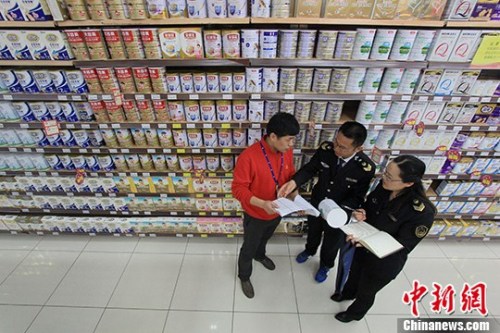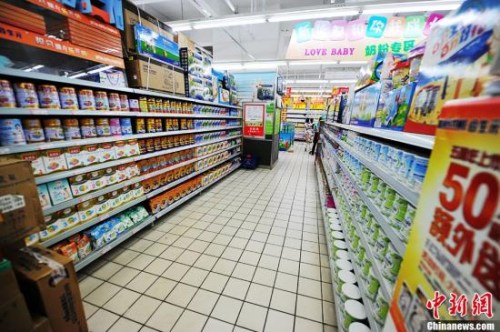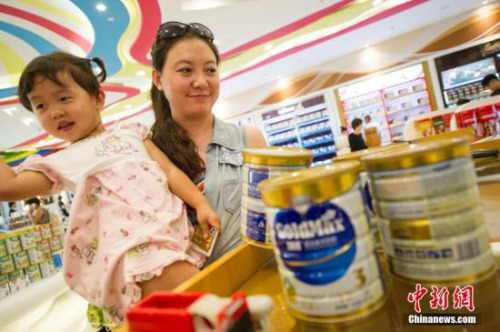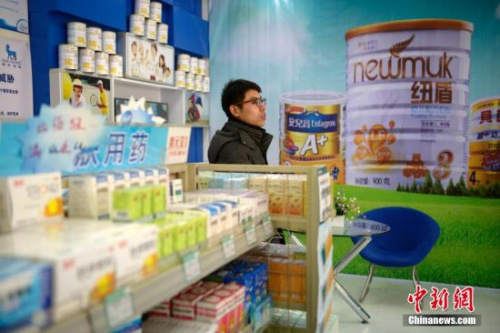After the standardization of infant milk powder labels, these words cannot appear on the packaging.

BEIJING, Beijing, December 20 (Qiu Yu) The enterprise’s self-inspection action on the label specification of infant formula milk powder is underway, and some expressions suspected of exaggerating publicity are banned. What words can’t appear on the packaging of infant milk powder? How big is the difference between high-end and low-end milk powder? What kind of brand do enterprises want to develop most after the new milk powder policy? A reporter from Zhongxin. com (WeChat WeChat official account: cns2012) conducted an investigation.
Information such as "intelligence, breastfeeding" is banned.
At the beginning of this month, the General Office of the State Food and Drug Administration issued the Notice on the Standardization, Supervision and Inspection of the Labeling of Infant Formula Milk Powder (hereinafter referred to as the Notice), requiring enterprises to conduct self-examination on the labeling of infant formula milk powder.
The "Notice" refers to seven aspects of labeling inspection of infant formula milk powder, including functional expressions such as not explicitly or implicitly improving intelligence, increasing resistance or immunity, and protecting intestines; Do not use vague information such as "imported milk source", "from foreign pasture" and "ecological pasture"; The label shall not use "human emulsification", "breast milk" or similar terms.
In this regard, after investigating the infant milk powder sold online and offline, the reporter found that some brands wrote "It is helpful for the normal development of baby’s vision" on the packaging, and some introduced that "the five-dimensional system of nutrition, absorption, digestion, immunity and intelligence is natural, safe and complete", and some brands emphasized "being friendly to the human body".
On some e-commerce platforms, some infant milk powder brands use expressions such as "imported milk source" and "pure close to breast milk" in advertising.
Several treasure mothers said that they didn’t know which nutrients had the function of improving intelligence or improving immunity, but some functional expressions on the packaging and the words "from foreign pastures" did have certain allure.

How big is the difference between high and low-end milk powder?
Take expressions such as improving intelligence or improving resistance as an example. Do these milk powders really have the above functions?
Song Liang, a senior dairy analyst and head of the industrial economic expert group of China Agricultural Reclamation Dairy Alliance, pointed out in an interview that the functional differences of different infant milk powders are not very big. At present, the research on infant milk powder in China is not perfect. Some enterprises claim that they have educational function by adding some nutritional elements, and more than 90% of these are exaggerated propaganda.
"The formula of infant milk powder mainly refers to international standards, and countries have fine-tuned it according to the national conditions," said Wang Dingmian, a dairy expert. In terms of the nutritional composition and content of milk powder, international standards give room for fluctuation, but the formulas of different countries are similar, and the so-called high-end milk powder and low-end milk powder are not very different.
Label identification is a sign to distinguish different commodity providers and an important reference for consumers to choose and buy goods.
In the interpretation of the Notice, the State Food and Drug Administration mentioned that the label exaggerated publicity, claims and other chaos caused confusion in the infant formula milk powder market, and also made it difficult for consumers to purchase infant formula milk powder.
Song Liang believes that the propaganda of infant milk powder in China is too strong, which may mislead consumers. As a result, consumers blindly pursue a certain function of milk powder and lose their rational view of the essence of milk powder.

The standard label is "the front station" of the new milk powder policy.
This is not the first time that the State Food and Drug Administration has stipulated the labeling of infant formula milk powder. In June this year, the State Food and Drug Administration issued the "Measures for the Administration of Formula Registration of Infant Formula Milk Powder Products" (hereinafter referred to as the "Measures"), which came into effect on October 1, 2016, with a transition period until January 1, 2018.
The "Measures" require applicants to submit sample labels and instructions, as well as descriptions and certification materials claimed in the labels and instructions when applying for registration, and make detailed provisions on the expression requirements of labels and instructions. These include information such as "intelligence" and "breast-feeding".
The "Measures", known as the "New Deal for Milk Powder", has a transitional period until 2018. Why do you carry out standardized labeling actions now?
"Standard labeling is to prepare for the formal implementation of the new milk powder policy, for the new policy ‘ Advance station ’ Wang Dingmian said that enterprises should have an adaptation process during the transition period. If there are still label violations after 2018, the production qualification may be cancelled.
In the interpretation of the Notice, the State Food and Drug Administration pointed out that at present, the registration of infant formula milk powder products has begun, in which the sample labels and instructions and their claims are important contents of the registration review. Enterprises do a good job in self-inspection and rectification of label identification, which is also a good foundation for the smooth application for product formula registration.
The Notice requires enterprises to carry out self-examination and self-correction within three months. In this regard, Song Liang pointed out that although the reserved time is short, the State Food and Drug Administration is steadily and orderly implementing the registration system. Label management first helps to reduce the industry-oriented publicity, which is of great significance in the whole process of formulation system landing.

Industry concentration increases. What kind of brands do enterprises want to keep?
In addition to standardizing labels, an important content of the Measures is to stipulate that each enterprise shall not exceed 3 series and 9 formulas. Some analysts said that this is conducive to the improvement of the concentration of milk powder industry.
Changjiang securities’s research report pointed out that domestic infant milk powder enterprises usually have many formulas, and some even have dozens of product series. However, in fact, there is little difference in the formulas of each product series. The implementation of the new regulations will prompt enterprises to cut down small brands with small sales and poor performance, which will help improve the concentration of milk powder industry.
Some people in the milk powder industry told reporters that many enterprises are carrying out "three actions". First, reduce brands. Before, it was common for an enterprise to have 30 or 50 brands, and there were more than 100 brands in individual enterprises. Now, enterprises have begun to shrink brands and formulas. The second is to reduce production, and enterprises have reduced the production quantity of some brands of milk powder. Third, promotion, through marketing means, try to sell the milk powder that has been produced during the transition period and reduce losses.
Wang Dingmian said that at present, the brands that enterprises hope to "keep" are mainly their own brands, brands with the best popularity and market share, and brands that are easy to sell and have high profits.
"After the brand concentration is improved, consumers and enterprises can establish a benign communication," Song Liang said. Enterprises can maintain their brands more carefully and ensure the order of sales channels; Consumers can have a deep understanding of a brand, and then make a relatively objective judgment. (End)